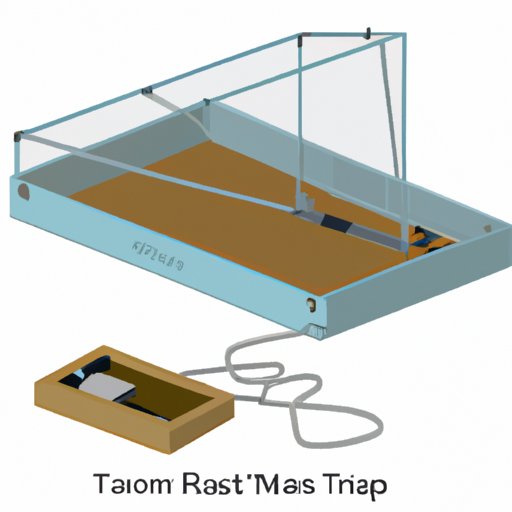Introduction
Dealing with mice can be a difficult problem to solve. If left unchecked, they can cause extensive damage to your home and contaminate your food. One effective way to deal with mice is setting a mouse trap. In this article, we’ll provide you with a comprehensive guide to set a mouse trap that is both safe and effective.
A Step-by-Step Guide
The preferred method of trapping a mouse is by using a snap trap. Here’s how to set it up:
Step 1: Get the Right Type of Snap Trap
There are many types of snap traps available in the market. Make sure to get one that suits your needs. We recommend using a wooden snap trap, as they are reliable and economical.
Step 2: Apply Bait on the Trigger
Spread a thin layer of peanut butter on the trigger of the snap trap. The scent will attract the mice, and they will try to take the bait.
Step 3: Set the Trap
Pull back the latch on each side of the trap and set it by placing the snapper bar over the trigger.
Step 4:Place the Trap in a Strategic Location
Place the trap against the wall, with the trigger end facing the wall. Mice tend to run along the baseboards, and this allows them to approach the trap easily.
Step 5: Check the Trap Regularly
Mouse traps need checking every day to see if they have caught a mouse. Check the trap daily, and reset it once you have taken the mouse out.
Step 6: Dispose of the Mouse
Your local council may have specific rules for disposing of dead animals, so check your area’s guidelines. Use gloves or a plastic bag to pick up the dead animal; this will prevent any germs from being transferred and keeps the area clean of germs and bacteria.
Comparison Article
There are different types of mouse traps available in the marketplace that you can use to deal with your rodent issues. It’s essential to evaluate the type of trap you’re going to use as some traps can be harmful to other animals besides mice.
Snap Traps
Snap traps are the most commonly used type of mouse traps. They are cheap, disposable, and effective. Snap traps work by snapping down on the mouse when it touches the trigger.
Glue Traps
Glue traps are considered one of the most inhumane types of traps. They work by using a sticky substance that glues the mouse to the board. Glue traps can take a considerable amount of time to capture a mouse, and they often scream or die from starvation before it happens.
Electronic Traps
Electronic Mouse Traps work by using electricity to kill the mouse. They are battery-operated and give an electric shock to the mouse when it touches both sides of the trap. It is an instant kill, leaving you to remove the mouse and dispose of it.
Tips and Tricks
Here are some tips and tricks to make mouse trapping more effective:
Baiting the Snap Trap
The key is to use sweet or oily foods like Peanut Butter, Nutella, or Biscuits. Mice have a sweet tooth and are attracted to sugary things.
Where to Place the Trap
Place the trap where you know the mouse is active. Common locations include behind large appliances like a refrigerator, cooker or washing machine. The small gaps in-between the cabinets and counters are also typical areas mice use to travel.
Dealing with False Triggers
False triggers can be caused by other substances like oil, dust, and other materials getting on the trap. Wipe the trap with a damp cloth, particularly the trigger area, to remove any debris.
Common Mistakes to Avoid
Here are the mistakes people make when setting mouse traps:
Placing the Trap in the Wrong Location
Placing the trap in the wrong location can lead to unsatisfactory results. Mice do not roam in the middle of a room as they prefer to stick to walls.
Not Enough Traps
If you have a mouse problem, you may need to set up several traps to be successful. You can use different types of traps in different locations around your home to maximize your chances of capturing mice.
Keeping Pests Out
Seal all the holes and cracks in your home where rodents may enter. They can enter through the tiniest gaps and cracks, like vents, doorways and windows and pipes coming in from the outside.
Safety Considerations
Your safety and that of your pets come first. Follow these guidelines to remain safe:
Handling the Snap Trap
Always use gloves when handling the Snap Trap. Mice carry diseases and bacteria that can be harmful to human and animal health.
Disposing of Dead Mice
Always dispose of dead mice immediately to prevent other animals smelling the dead mouse and trying to eat it.
Alternatives to Traditional Mouse Traps
Here are some alternatives to traditional mouse traps:
Humane Mouse Traps
Humane Mouse Traps are designed to catch a mouse without harming it. You can release them in the wild, far enough from your home to prevent them from returning.
Professional Pest Control Services
Professional Pest Control Services are companies that can help you handle pest problems. They are equipped with the latest technology and are trained to handle pest problems safely.
Conclusion
Dealing with a mouse problem can be challenging, but with the right tools and techniques, it can be conquered. By following this guide, you will be better equipped to remove mice from your home. Remember to always practice good hygiene and follow safety precautions when dealing with mice.
